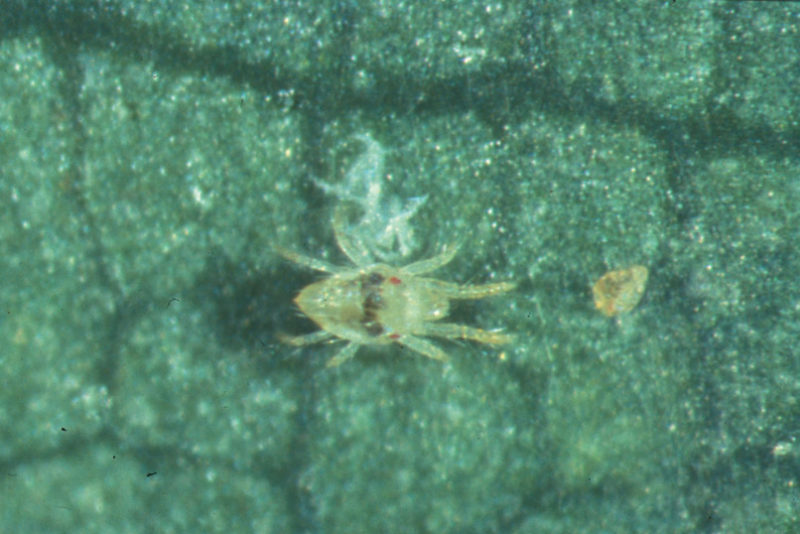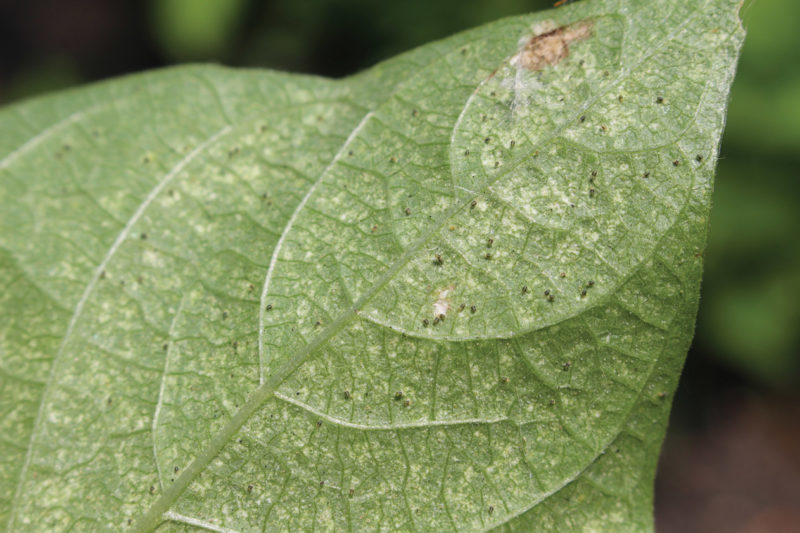
Dr. Bugs: How Pesticides Influence Spider Mites
Answer: You ask a very important question, as some insect and mite pests have developed mechanisms that allow them to sense and avoid pesticides (insecticides and miticides), especially those in the chemical classes pyrethroid and organophosphate.
The effect of pyrethroid-based pesticides on twospotted spider mite, Tetranychus urticae, populations may not be associated with eliminating biological control agents (primarily predatory mites) or disrupting natural regulation. Instead, some pyrethroid-based pesticides have repellent activity that can result in twospotted spider mite populations increasing their spatial (space) distribution on plants.
Pyrethroid-based pesticides with repellent activity can cause twospotted spider mite populations to disperse within and/or among plants, thus increasing their distribution among crops in a greenhouse. In fact, pyrethroid-based pesticides can influence the dispersal behavior of the twospotted spider mite, which may affect pesticide effectiveness.
Research has evaluated the effects of pyrethroid-based pesticides on twospotted spider mite populations. Twospotted spider mite population outbreaks typically occur following the application of pyrethroid-based pesticides to plants. Pyrethroids act as direct toxicants, repellents, irritants and antifeedants, which can influence the behavior of twospotted spider mites on plants. For example, applications of pyrethroid-based pesticides that repel twospotted spider mites can increase the dispersal capability of twospotted spider mites on plants, resulting in uneven distribution on plants, which could affect pesticide effectiveness — especially if spray coverage is inadequate.

Twospotted spider mites avoid plant surfaces treated with a pyrethroid-based pesticide and colonize locations or other plants that have not been treated with a pyrethroid-based pesticide. Twospotted spider mites will move from treated plant leaf surfaces to untreated plant leaf surfaces, which will enhance the spatial distribution of this pest and contribute to the spread of an infestation. Twospotted spider mites will leave plants by simply walking away from or avoiding treated plant leaf surfaces. Twospotted spider mites may respond differently to plant surfaces treated with pyrethroid-based pesticides than untreated plant surfaces.
For example, twospotted spider mite females exposed to plants treated with pyrethroid-based pesticides produce more eggs than on untreated plant surfaces or those containing the lowest concentration of pesticide residues. In addition, changes in dispersal of twospotted spider mites on treated plants, reproductive rate of females and development rate may contribute to increases in populations that are higher than on untreated plants. Also, twospotted spider mite females will lay eggs in silks or on trichomes (hairs) when residues of pyrethroid-based pesticides are present on treated leaf surfaces. Moreover, twospotted spider mite populations on pyrethroid-based pesticide treated plants may have a skewed sex ratio (more males than females) than twospotted spider mites on untreated plants if the pyrethroid-based pesticide is more toxic to one sex than the other.

The response time affiliated with dispersal on plant surfaces is dependent on the rate applied and the pyrethroid-based pesticide used. Also, the dispersal of twospotted spider mites on plant surfaces may depend on the extent of the repellent activity of pyrethroid-based pesticides. In addition, the effect of pyrethroid-based pesticides on twospotted spider mite populations can vary depending on the product used. For example, bifenthrin (Talstar) may induce twospotted spider mite outbreaks whereas tau-fluvalinate (Mavrik) may not because Mavrik is a pyrethroid-based pesticide with miticidal activity.
So, when applying certain pesticides, you may want to consider the potential behavioral effects, not only on the twospotted spider mite, but also on other insect and mite pests of greenhouse-grown horticultural crops including aphids, broad mite, thrips and whiteflies.
For an enhanced reading experience, view this article in our digital edition by clicking here.


 Video Library
Video Library 




















